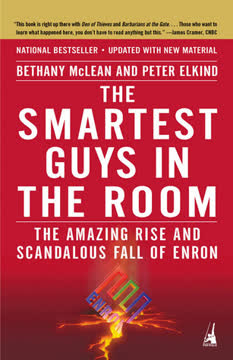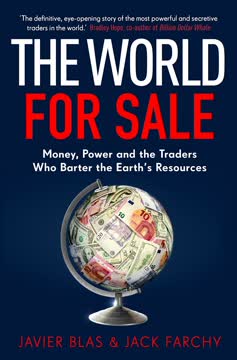Key Takeaways
1. Rajat Gupta's rise from orphan to McKinsey's first non-American global managing director
"If I look back on my time as MD and where I made the most impact, I would pick the time when the bubble was going on and it was fascinating because lots and lots of people were getting instantly rich."
From orphan to global leader. Rajat Gupta's journey began in Calcutta, India, where he was orphaned at a young age. Through sheer determination and intelligence, he excelled academically, earning a spot at the prestigious Indian Institute of Technology (IIT) and later Harvard Business School. His career at McKinsey & Company was marked by steady progress and groundbreaking achievements:
- First Indian partner at McKinsey
- Turned around McKinsey's Scandinavian practice
- Elected as the first non-American global managing director in 1994
Transforming McKinsey. Under Gupta's leadership, McKinsey experienced unprecedented growth and global expansion:
- Doubled the number of consultants to 7,700
- Increased revenue from $1.2 billion to $3.4 billion
- Expanded from 58 to 84 offices worldwide
However, Gupta's tenure was not without controversy. His aggressive growth strategy and focus on increasing partner compensation strained the firm's culture and values, leading to tensions with the old guard and setting the stage for his eventual downfall.
2. The emergence of insider trading networks among South Asian executives on Wall Street
"There cannot be an island of riches in an ocean of poverty."
The rise of South Asian talent. The 1980s and 1990s saw a significant influx of highly educated South Asian immigrants into Wall Street firms. These individuals, often with backgrounds in engineering and technology, were well-suited to the increasingly quantitative nature of finance. Key factors contributing to their success included:
- Strong educational backgrounds from prestigious institutions in India and the US
- Analytical skills that aligned with the growing complexity of financial products
- Networking within the South Asian community to share opportunities and information
The dark side of success. As South Asian executives climbed the corporate ladder, some began to form insider trading networks. These networks were often built on:
- Shared cultural backgrounds and experiences
- A desire to prove themselves in a competitive industry
- The temptation of quick wealth in a booming market
The emergence of these networks highlighted the tension between the drive for success and ethical business practices, ultimately leading to one of the largest insider trading scandals in Wall Street history.
3. Raj Rajaratnam's journey from Sri Lankan immigrant to billionaire hedge fund manager
"You know, you go to the casino, you say okay, you know Schlumberger, which is a great company, was at 100, it's 82, right?…And you just don't know whether it's gonna go to 70."
From outsider to insider. Raj Rajaratnam arrived on Wall Street in the 1980s, quickly distinguishing himself as a talented analyst in the technology sector. His career progression included:
- Starting at Chase Manhattan Bank's credit program
- Moving to Needham & Co., where he became president
- Founding Galleon Group in 1997, which grew to manage over $7 billion
Building an information network. Rajaratnam's success was built on his ability to cultivate a vast network of corporate insiders who provided him with valuable, non-public information. His methods included:
- Leveraging his South Asian connections in Silicon Valley
- Offering to invest in the hedge funds of those who provided information
- Using "soft dollar" arrangements to reward sources
Rajaratnam's approach blurred the lines between aggressive information gathering and illegal insider trading, ultimately leading to his downfall and a 11-year prison sentence.
4. The SEC's painstaking investigation into Galleon Group's suspicious trading activities
"This is our best shot at getting into hedge fund insider trading."
Connecting the dots. The SEC's investigation into Galleon Group began with a tip about suspicious trading at a small hedge fund called Sedna Capital. Key steps in the investigation included:
- Analyzing trading patterns and communications between Raj Rajaratnam and his brother Rengan
- Identifying a network of corporate insiders providing information to Galleon
- Collaborating with the U.S. Attorney's Office to build a criminal case
Overcoming challenges. The investigation faced numerous obstacles:
- The complexity of Galleon's trading activities and vast information network
- Difficulty in proving that trades were based on inside information rather than legitimate research
- The need to gather enough evidence to justify more intrusive investigative techniques
The SEC's persistence and methodical approach eventually led to breakthrough evidence, setting the stage for the use of wiretaps and the eventual downfall of Galleon Group.
5. The pivotal role of wiretaps in uncovering the extent of insider trading at Galleon
"Please don't fuck me on this... [Akamai] they're gonna guide down."
Breaking new ground. The use of wiretaps in the Galleon case marked a significant shift in white-collar crime investigations. Key aspects of the wiretap operation included:
- First-ever use of wiretaps in an insider trading case
- Real-time monitoring of Rajaratnam's cell phone conversations
- Capture of explicit discussions about insider information and trading strategies
Damning evidence. The wiretaps provided prosecutors with compelling evidence of insider trading:
- Recorded conversations revealing the exchange of confidential information
- Clear links between the receipt of inside information and subsequent trades
- Insights into the vast network of corporate insiders feeding information to Galleon
The wiretaps not only strengthened the case against Rajaratnam but also implicated numerous other individuals, including high-profile executives and consultants, in the insider trading scheme.
6. Anil Kumar's transformation from respected consultant to Rajaratnam's inside source
"I am being treated like a confidant by the CEO. I am part of his senior-most four, five, six people thinking through how AMD is going to win in the marketplace."
From consultant to informant. Anil Kumar, a respected McKinsey partner, became one of Rajaratnam's most valuable sources of inside information. His journey included:
- Meeting Rajaratnam at Wharton Business School
- Reconnecting years later when Kumar was struggling at McKinsey
- Agreeing to provide confidential information in exchange for payments
The price of insider information. Kumar's arrangement with Rajaratnam involved:
- Setting up offshore accounts to receive payments
- Providing detailed information on McKinsey clients, particularly AMD
- Receiving up to $1 million per year for his tips
Kumar's case illustrates how even highly successful professionals can be tempted by the allure of easy money and insider status, ultimately compromising their ethics and careers.
7. The Goldman Sachs board leak that ultimately led to Gupta's downfall
"I heard yesterday from somebody who's on the Board of Goldman Sachs, that they are gonna lose $2 per share. The Street has them making $2.50."
A fateful phone call. On October 23, 2008, immediately following a Goldman Sachs board meeting, Rajat Gupta called Raj Rajaratnam and disclosed confidential information about the bank's expected quarterly loss. This leak led to:
- Rajaratnam quickly selling his Goldman Sachs holdings, avoiding significant losses
- A clear trail of evidence linking Gupta's board participation to Rajaratnam's trades
- The eventual indictment and conviction of Gupta for insider trading
The consequences of betrayal. Gupta's actions had far-reaching implications:
- Destroyed his reputation as a respected business leader and philanthropist
- Undermined trust in corporate governance at the highest levels
- Highlighted the pervasive nature of insider trading, even among elite executives
This incident served as a stark reminder of the importance of maintaining confidentiality and ethical behavior in corporate boardrooms.
8. The impact of the 2008 financial crisis on Wall Street's insider trading networks
"It's now reached a point where it's physically and humanly impossible to do the things he's doing right."
Desperation breeds corruption. The 2008 financial crisis created a perfect storm for insider trading:
- Extreme market volatility increased the value of inside information
- Financial pressures tempted even previously honest individuals to engage in illegal activities
- The complexity of financial products made it harder to detect suspicious trading
Heightened scrutiny and enforcement. As the crisis unfolded, regulators and law enforcement intensified their efforts:
- Increased resources devoted to detecting and prosecuting financial crimes
- Greater cooperation between different agencies (SEC, FBI, DOJ)
- Use of more aggressive investigative techniques, including wiretaps
The crisis ultimately exposed the extent of insider trading networks on Wall Street, leading to numerous high-profile prosecutions and a renewed focus on ethical behavior in the financial industry.
9. The human cost of insider trading: broken trust, ruined careers, and shattered reputations
"I can't believe I am sitting here."
Lives destroyed. The Galleon insider trading scandal had devastating consequences for those involved:
- Raj Rajaratnam: From billionaire hedge fund manager to federal prison inmate
- Rajat Gupta: Lost his reputation, board positions, and freedom
- Anil Kumar: Forced to admit to his crimes and cooperate with prosecutors
Ripple effects. The scandal's impact extended far beyond the main players:
- Families of those convicted faced public shame and financial hardship
- Colleagues and associates had their careers tainted by association
- Investors in Galleon and other implicated funds suffered significant losses
The human toll of the insider trading scandal served as a stark reminder of the personal and professional consequences of unethical behavior in the financial industry, underscoring the importance of integrity and ethical decision-making in high-stakes environments.
Last updated:
FAQ
What's The Billionaire's Apprentice about?
- Insider Trading Scandal: The book chronicles the rise and fall of Rajat Gupta and Raj Rajaratnam, two prominent figures in finance, involved in a major insider trading scandal.
- Cultural Context: It explores the journey of Indian-Americans and South Asian immigrants, highlighting their rise to prominence and the complexities of their dual identities.
- Legal Proceedings: The narrative details the investigations, trials, and legal strategies, providing insight into the complexities of white-collar crime.
Why should I read The Billionaire's Apprentice?
- Unique Perspective: Offers a look at the intersection of culture, ambition, and ethics in finance, particularly through the lens of Indian-American experiences.
- Real-Life Drama: Presents a gripping true story filled with intrigue, ambition, and moral dilemmas, engaging for those interested in business ethics and legal battles.
- Lessons on Ethics: Serves as a cautionary tale about the importance of integrity and the potential fallout from unethical decisions in business.
What are the key takeaways of The Billionaire's Apprentice?
- Consequences of Insider Trading: Illustrates the severe legal and personal repercussions of insider trading, emphasizing that no one is above the law.
- Cultural Identity: Emphasizes the dual identity of Indian-Americans, showcasing their struggles and triumphs while navigating their cultural heritage.
- Impact of Relationships: Highlights how personal and professional relationships can significantly influence one's career trajectory, for better or worse.
Who are the main characters in The Billionaire's Apprentice?
- Rajat Gupta: Former head of McKinsey & Company, portrayed as a successful yet flawed leader whose involvement in the scandal leads to his downfall.
- Raj Rajaratnam: Head of the Galleon Group, depicted as a savvy trader whose aggressive tactics and insider connections drive the central conflict.
- Anil Kumar: Gupta's protégé and a key figure in the scandal, whose decisions and relationships play a crucial role in the unfolding events.
How does The Billionaire's Apprentice address the theme of ethics in business?
- Moral Dilemmas: Delves into the ethical challenges faced by Gupta and Rajaratnam, particularly regarding insider trading and its consequences.
- Consequences of Actions: Illustrates how unethical behavior can lead to devastating personal and professional repercussions, emphasizing integrity.
- Cultural Expectations: Explores how cultural backgrounds influence ethical perspectives, especially in the context of immigrant experiences in America.
What role did Anil Kumar play in the insider trading scandal?
- Key Informant: Became a crucial informant for the government, providing insider information that implicated Rajaratnam and others.
- Consultant to Galleon: His position allowed access to sensitive information, which he relayed to Rajaratnam, highlighting the moral conflict.
- Moral Conflict: His cooperation with authorities reflects the dilemmas faced by individuals caught in illegal activities, weighing personal gain against legal consequences.
How did the SEC and FBI build their case against Raj Rajaratnam?
- Wiretaps and Surveillance: Utilized wiretaps to gather evidence of Rajaratnam's communications, capturing incriminating conversations.
- Cooperating Witnesses: Key figures like Anil Kumar provided testimony and evidence that helped establish a pattern of insider trading.
- Documentary Evidence: Included a thorough review of trading records, emails, and instant messages linking Rajaratnam to insider information.
What was the significance of the AMD-ATI merger in The Billionaire's Apprentice?
- Major Insider Trading Event: The merger was pivotal, as Rajaratnam profited significantly from insider information about the deal.
- Impact on Galleon: Showcased Rajaratnam's ability to leverage insider information for financial gain, drawing regulatory attention.
- Culmination of Kumar's Tips: Exemplified the dangerous intersection of consulting and insider trading, leading to Kumar's cooperation with the government.
What were the legal outcomes for Raj Rajaratnam and Rajat Gupta?
- Raj Rajaratnam's Conviction: Convicted on multiple counts of insider trading and sentenced to eleven years in prison, setting a legal precedent.
- Rajat Gupta's Sentence: Found guilty of insider trading and conspiracy, receiving a two-year prison sentence, marking a significant fall from grace.
- Impact on Careers: Both faced severe repercussions, with Gupta losing corporate board positions and Rajaratnam's hedge fund collapsing.
How does The Billionaire's Apprentice reflect on the broader implications of insider trading?
- Corporate Governance: Raises questions about the effectiveness of corporate governance and board members' ethical responsibilities.
- Public Trust: Highlights the erosion of public trust in financial institutions when high-profile figures engage in unethical behavior.
- Cultural Commentary: Serves as a commentary on cultural attitudes towards wealth and success, particularly within immigrant communities.
What lessons can be learned from The Billionaire's Apprentice?
- Importance of Ethics: Underscores the necessity of maintaining ethical standards in business, as the consequences of failing to do so can be devastating.
- Vigilance in Oversight: Highlights the need for robust oversight mechanisms to prevent insider trading and protect investors.
- Personal Accountability: Emphasizes the importance of personal accountability and the impact of one's actions on family, friends, and community.
What is the significance of the title The Billionaire's Apprentice?
- Symbol of Ambition: Reflects the aspirational journey of Gupta and others seeking to rise to the top of the financial world, often at great personal cost.
- Mentorship Dynamics: Suggests the mentor-mentee relationships central to the narrative, particularly between Gupta and Kumar.
- Cautionary Implications: Implies a learning process, highlighting lessons learned through the characters' experiences, both positive and negative.
Review Summary
The Billionaire's Apprentice is praised for its meticulous research and gripping narrative of the Galleon insider trading scandal. Readers appreciate the detailed portrayal of key figures, particularly Rajat Gupta and Raj Rajaratnam, and the exploration of the Indian-American diaspora's rise in the U.S. The book is commended for its thriller-like pace and insights into Wall Street practices. Some critics found the writing style and time-jumping structure challenging, but most reviewers consider it a compelling and informative read on white-collar crime and the dangers of unchecked ambition.
Similar Books










Download PDF
Download EPUB
.epub digital book format is ideal for reading ebooks on phones, tablets, and e-readers.




